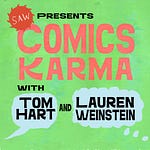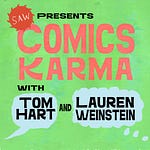Episode 4 - Building the Dream Castle
Today on Episode Four of The Terrible Anvil, we tried to tackle the topic of making a sustainable creative physical space and habits to make work.
And as usual we veered off topic and expanded and waxed philosophical on all the different types of "castles" creatives build: the physical workspace, the vision for the work itself, the audience you hope to reach.
I (Jess) also am editing a book (The Bootlegger's Guide to Comics!) and we took a topic from the early draft wondering: What's the purpose of an audience or editor, and when to open the door of your castle to share work?
Lots more on the show page here: https://members.sawcomics.org/posts/the-terrible-anvil-episode-4-building-the-dream-castle-50384315
THE ZOOM AI made this summary and it’s not bad:
Meeting summary for The terrible Anvil Episode 4 (02/08/2024)Quick recap
Tom and Jess discussed their podcast format and an upcoming episode focusing on the concept of 'building a dreamcastle' in relation to creating an optimal workspace. They also touched upon the value of editors and audience in the creative process. The discussion also included feedback and maintaining conversation flow. They considered the importance of having a space that inspires them and makes them feel proud and safe. They discussed the tension between creating for oneself and considering the audience and potential editors. They also explored the impact of social media on the creative process.
SummaryPodcasting and Comics: Building Dreamcastles and Balancing Feedback
Tom and Jess discussed their podcast format and an upcoming episode where they plan to discuss the concept of 'building a dreamcastle' in relation to creating an optimal workspace. They also mentioned a future project, The Bootleggers Guide to Making Comics, which involves testing material for a book. The discussion also touched upon the value of editors and audience in the creative process. They were open to feedback and planned to strike a balance between answering questions and maintaining the flow of the conversation.
Dreamcastles: Ideal Workspace Concept
Tom Hart @ SAW and Jess discussed the concept of "dreamcastles," a metaphorical term they use to describe the ideal workspace for creating and managing their projects. They talked about the importance of having a space that inspires them and makes them feel proud and safe. Jess shared her experience of showcasing her workspace to others and how it can lead to discussions about tools and techniques. Tom mentioned visiting artists who use color-coded systems on their walls to manage their stories. The conversation ended with the idea of using the "dreamcastle" metaphor to represent the process of creating a project, not just the physical space.
Creative Process and Social Media Influence
Jess and Tom discussed the creative process, focusing on the creation of a 'dream castle' as a metaphor for their artistic vision. They explored the tension between creating for oneself and considering the audience and potential editors. Jess emphasized the importance of creating a first draft without the pressure of audience expectations before making edits. They also discussed the impact of social media on the creative process, with Jess highlighting the pressure to share polished work on platforms such as Instagram. On the other hand, platforms like Patreon and the Mighty Network provide a space for sharing works-in-progress. The conversation concluded without a definitive answer on how to balance these influences.
Graphic Novel and Memoir Project Discussion
Tom and Jess discussed their ongoing project involving lettering and storytelling. Jess shared her experience of completing her graphic novel and feeling a need for a new project, which led her to collaborate with her partner on a memoir that she felt would be better suited as a comic. She also mentioned her interest in a larger project that could encapsulate stories from healthcare workers. Tom suggested focusing on the creative process first before considering its relevance to the broader world. They both agreed that the importance of their work should come before its cultural relevance.
Breaking Into Animation: Challenges and Advice
Tom Hart @ SAW shared his experiences with trying to break into the animation industry and the advice he received from a woman who ran Cartoon Network at the time. He highlighted the challenge of finding a unique angle for a project that commercial institutions like Cartoon Network would be interested in. Jess agreed with Tom's perspective and discussed the difficulty of creating stories that stand out in a crowded market. They also touched upon the importance of focusing on the creative process and not overthinking the audience or potential editors. Towards the end, Jess suggested the idea of a three-month nonfiction class featuring Tom, but noted that it was likely too late to implement the change.
Questions, Narratives, and Behind-the-Scenes in Creative Works
Jess and Tom Hart @ SAW engaged in a discussion about the utility of questions in organizing and synthesizing information, especially in large bodies of work. They emphasized the importance of personal narratives in creative works, noting that they will naturally seep into the work if deeply ingrained. They also discussed the balance between stats and facts in storytelling, particularly in the context of comics and graphic novels. They concluded by noting the trend of including behind-the-scenes content in books.
Art, Community, and Digital Tools
Tom Hart @ SAW and Jess had a discussion about the value of personal, ritualistic art and its role in community building. They emphasized the importance of transparency in the creative process and the communal aspect of art. They also touched upon their preferences in creating comics and their observations about the different ways people work. They both agreed on the potential of portability in tools and workspaces, and the convenience of working on digital platforms. Towards the end, they discussed the importance of lettering in comics and agreed to reconvene next week to discuss it. They also considered starting a thread on the Mighty Network about workspaces and potential book projects.
Next steps•
Jess will create a recap of the discussion and consider starting a thread on the Mighty Network about workspaces.
--------------------------------
The Terrible Anvil!
How do you make comics without all the frustration? Without feeling lousy and inadequate all the time? With the Terrible Anvil of daily deadlines! And a community, and mindset shift about what it means to make comics and art. Jess Ruliffson and Tom Hart are working through the whole process, one piece at a time, turning frustration into fun and glee.
💬ONLINE COURSES SAW is a SCHOOL with loads of online courses you can see here: https://learn.sawcomics.org/
💬COMMUNITY REMINDERS! You can also join hundreds of people sharing their work at our free members site
https://members.sawcomics.org/share/F6BBQeyGUGE0g-Qk?utm_source=manual
💬 DONATIONS Thanks so much for being here! SAW Comics is a 501C-3 non-profit and we thrive on your support and donations! You can support these workshops, plus the many many ways in which we strive to meet our mission of training and supporting graphic novelists.
You can support us on Patreon or PayPal, here: https://www.paypal.me/comicsworkshop
https://patreon.com/sawcomics
Venmo: sequentialartists-workshop Or become a sustaining donor: https://learn.sawcomics.org/courses/saw-sustaining-member-donation
Recorded at SAW on Zoom, Feb 2024
THANKS!

















Share this post